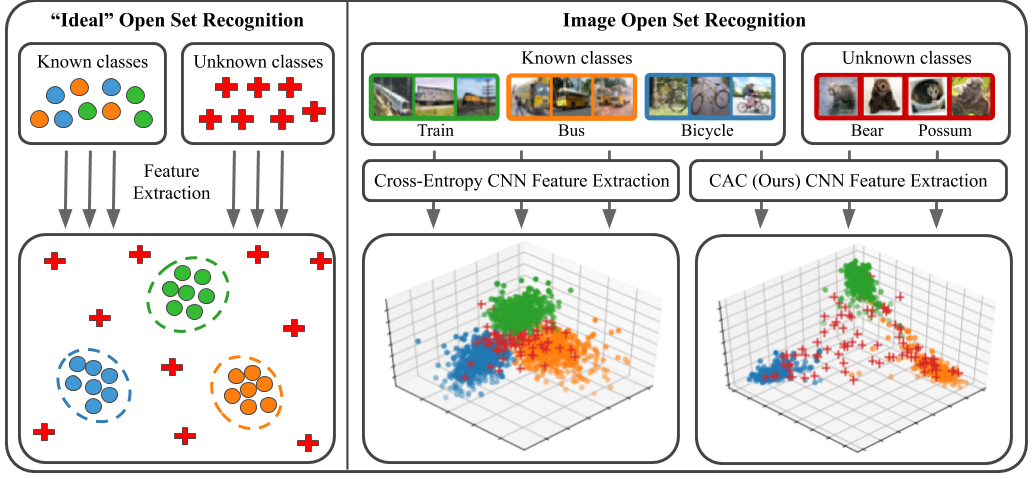Class Anchor Clustering (CAC) loss is an entirely distance-based loss the explicitly encourages training data to form tight clusters around class-dependent anchor points in the logit space.
This repository contains the training and evaluation code from the paper:
Class Anchor Clustering: a Distance-based Loss for Training Open Set Classifiers
Dimity Miller, Niko Suenderhauf, Michael Milford, Feras Dayoub
Published at the 2021 IEEE/CVF Winter Conference on Applications of Computer Vision (WACV).
If you use this work, please cite:
@inproceedings{millerclass,
title={Class Anchor Clustering: A Loss for Distance-Based Open Set Recognition},
author={Miller, Dimity and Suenderhauf, Niko and Milford, Michael and Dayoub, Feras},
booktitle={Proceedings of the IEEE/CVF Winter Conference on Applications of Computer Vision},
pages={3570--3578}
}
Contact
If you have any questions or comments, please contact Dimity Miller.
This code was developed with Python 3.6 on Ubuntu 16.04. It currently requires a GPU.
We have included the cac.yml file for the conda environment we used during this project. To create your own conda environment you can run:
conda env create -f cac.ymlYou should then activate this environment before running any of the code:
conda activate cacPython requirements can be installed by:
pip install -r requirements.txtThis code uses MNIST, SVHN, CIFAR10, CIFAR100 and Tiny ImageNet.
These datasets should be available in the datasets/data/ folder inside this repository.
These datasets will be downloaded automatically if you run the code and they are not available in the datasets/data/ folder.
Run the following to download and setup TinyImageNet.
cd datasets/data/
./tinyimagenet.shThe trained models used for our paper can be found in the 'networks/weights/' folder.
CAC-trained open set classifier weights are stored as:
datasetName/datasetName_trialNumber_CACclassifierAnchorLoss.pth
Cross-entropy-trained (CE) closed set classifier weights are stored as:
datasetName/datasetName_trialNumber_closedSetClassifier.pth
where:
datasetNameis one of: MNIST, SVHN, CIFAR10, CIFAR+10, CIFAR+50, TinyImageNettrialNumbercan be trial 0-4.
If you wish to evaluate these networks, leave the --name argument blank for the evaluation scripts.
The known/unknown class split for each dataset corresponds to 'trial' files.
These files can be found in datasets/datasetName/class_splits/trialNumber.json where datasetName is MNIST, SVHN, CIFAR10, CIFAR+10, CIFAR+50 or TinyImageNet.
Each trial file contains a dictionary that holds the known/unknown class split information. For example, CIFAR10/class_splits/0.json contains:
{"Known": [6, 8, 2, 4, 9, 3], "Unknown": [1, 5, 7, 0]}
This indicates that classes 2, 3, 4, 6, 8 and 9 in CIFAR10 are 'known' and classes 0, 1, 5 and 7 are 'unknown' during training.
You can create your own trialNumber.json file with a custom known/unknown class split. The trialNumber must be an integer number and you must reference this when calling the training script (as detailed below).
python train_cacOpenset.py --dataset dsName --trial tNum where:
dsNameis the dataset to train on. Must be one of: ['MNIST', 'SVHN', 'CIFAR10', 'CIFAR+10', 'CIFAR+50', 'TinyImageNet']tNumis the trial number corresponding to the known/unknown class split. Trial 0-4 were used in this paper.
Optional arguments:
-rto resume training from a checkpoint with a lower learning rate.--alpha awhere a is the magnitude of the anchor point--lbda lwhere l is the weighting of the Anchor component of CAC loss-tto plot the training curves on tensorboardX--name nuses n in the name for tensorboard and saving the weights. By default it is "myTest".
python train_closedSet.py --dataset dsName --trial tNum where:
dsNameis the dataset to train on. Must be one of: ['MNIST', 'SVHN', 'CIFAR10', 'CIFAR+10', 'CIFAR+50', 'TinyImageNet']tNumis the trial number corresponding to the known/unknown class split. Trial 0-4 were used in this paper.
Optional arguments:
-rto resume training from a checkpoint with a lower learning rate.-tto plot the training curves on tensorboardX--name nuses n in the name for tensorboard and saving the weights. By default it is "myTest".
The evaluation scripts calculate the classification accuracy on the known classes and AUROC open set performance on separating known and unknown classes. For the paper, we calculate this performance averaged over trials 0-4.
For CAC-trained classifiers:
python eval_cacOpenset.py -dataset dsName For CE-trained classifiers:
python eval_closedSet.py -dataset dsName where:
dsNameis the dataset to evaluate. Must be one of: ['MNIST', 'SVHN', 'CIFAR10', 'CIFAR+10', 'CIFAR+50', 'TinyImageNet']
Optional arguments:
--num_trials ntwhere nt is the number of trials to average performance over. By default it is 5. To evaluate one network you have trained, use nt as 1.--start_trial stwhere st is the starting trial number for evaluation. By default it is 0. You can change this to a custom trial number you have created and trained on.--name nuses n is the name used when saving the weights. By default it is "". If you have trained your own networks, use "myTest".
